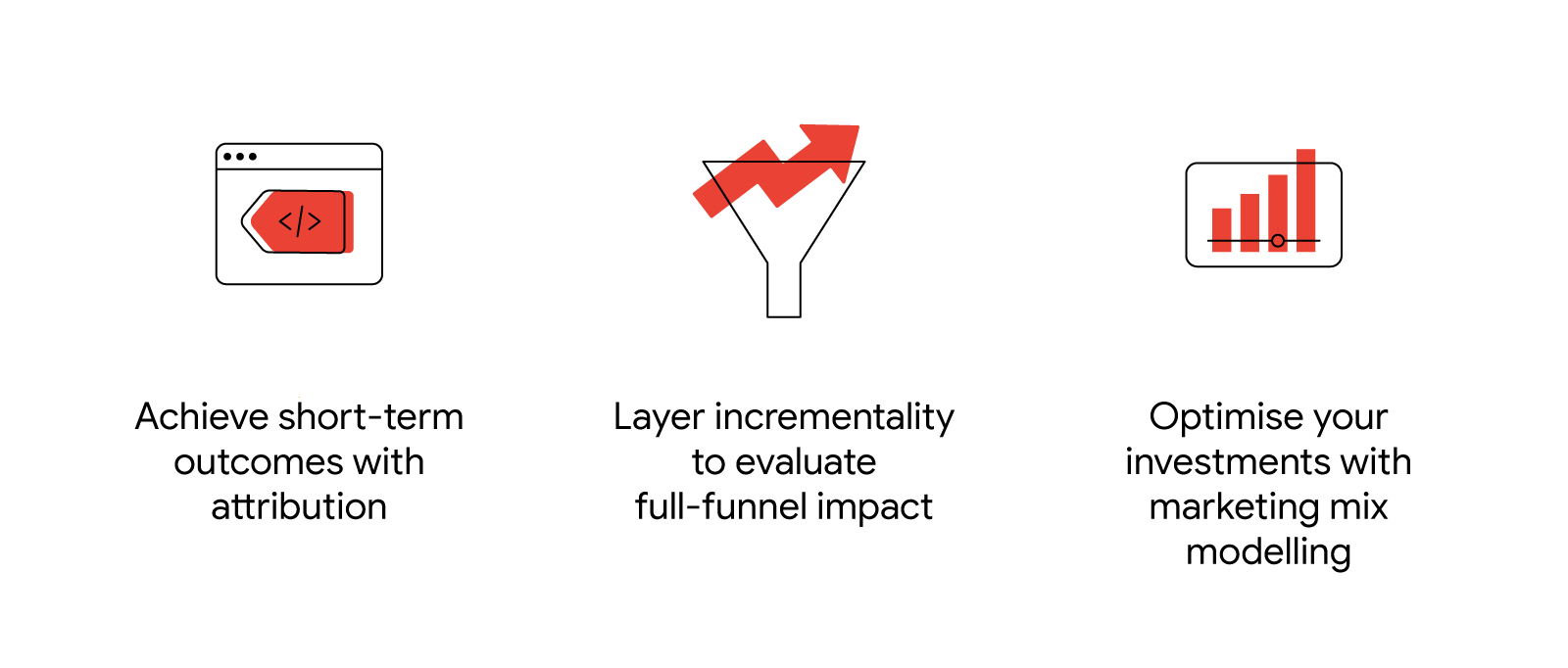In today’s uncertain economy, video marketers may find it difficult to keep calm and carry on. For most, measuring the effectiveness of their media investments will be a top priority. And while focusing on measurement can help marketers fuel both short-term and long-term growth, not all measurement approaches are created equal. Success depends on having the right media strategies and tools.
It may be tempting, for instance, to concentrate only on immediate results during disruptive times. But savvy marketers will combine their short-term and long-term business goals and take a more holistic full-funnel approach to YouTube. Indeed, recent research by Nielsen shows that brands that added upper-funnel marketing efforts to existing mid-funnel campaigns were able to boost return on investment (ROI) by 70%. And brands that added upper-funnel tactics to campaigns that covered the middle and lower funnels were able to raise ROI by 13%.
Proving the value of a full-funnel video strategy requires using measurement tools and tactics that leverage how upper-funnel brand goals and lower-funnel performance objectives play off each other. To do this successfully, marketers can use an effective three-part framework that balances tried-and-new methods with newly emerging measurement practices. Two parts of the framework — attribution and incrementality — help set you up for short-term business outcomes, while the third part — marketing mix modelling — can help you make smarter decisions for the long haul.
Here is a deeper look at how to apply the framework.

Achieve short-term outcomes with attribution
These days, using an attribution model that assigns credit for conversions to different ads that occur across the customer journey should be standard practice. When it’s done right, attribution can help marketers easily optimise their ad strategies. Google’s data-driven attribution model can help you analyse your customers’ journey across Search, YouTube, and Display to discover which touchpoints are most effective.
In a privacy-first world, having multiple sources of truth for measurement will be critical.
While attribution can help you uncover and optimise for opportunities quickly, it’s important not to treat it as a stand-alone measurement solution. Relying only on attribution insights to optimise your plans may provide quick growth, but it will come at the risk of not investing in the upper-funnel branding strategies that constantly refuel the pool of customer demand. Additionally, as measurement becomes more challenging in a privacy-first world, having multiple sources of truth instead of relying solely on attribution will be critical. To take attribution to the next level, pair it with incrementality.
Layer incrementality to evaluate full-funnel impact
One powerful way to supplement attribution and take your measurement mix to the next level is to include incrementality. Generally defined as a lift or increase in a desired outcome, incrementality helps you understand the KPI uplift due to your ad. As a result, incrementality can help you better understand the impact of full-funnel campaigns and pave the way for longer term growth.
Incrementality can help you better understand the impact of full-funnel campaigns and pave the way for longer-term growth.
The primary way to measure incrementality is to measure the performance of your full-funnel video strategy using various lift metrics. Google offers an array of solutions to measure lift across the customer journey, including Brand Lift , Search Lift, and Conversion Lift. When combined into one unified view of measurement, Google uses these metrics to showcase the value and impact of YouTube full-funnel campaigns that span all marketing objectives to help you understand the effectiveness of each.
Incrementality should never be treated as a one-off exercise, regardless of the outcome. Embracing a test-and-learn mindset will better position brands for resilience and long-term growth. Harvard Business Review found that marketers who run multiple tests see up to 30% higher ad performance. Once you have results in hand, optimise your media accordingly. Keep in mind that it’s critical to continue gathering insights and refining your strategy beyond your initial tests. Building experimentation into your overall measurement plan will help ensure that you are consistently optimising and refining over time.
Optimise your investments with marketing mix modelling
Marketing mix modelling (MMM) is a tried-and-true, privacy-durable way to measure the impact of all YouTube formats across the funnel. It is also an effective way to capture both the short- and long-term impact of marketing investments. Using longitudinal online and offline data, MMMs provide you with the ROI for each media channel. Not only should these studies be used to show how media channels performed in the past, they should be used to optimise your media allocations moving forward.
Results from MMM studies take into account a combination of variables, so it’s critical to break out YouTube from other video platforms where possible. A Nielsen study found that the return on ad spend from marketing mix models varied by as much as 48% when video platforms were individualised versus when they were aggregated together. And format-level insights provide the most actionable level of granularity, especially when it comes to a full-funnel mix. Inputs matter when it comes to your model.
Researchers found that marketers who run multiple tests see up to 30% higher ad performance.
Economic uncertainty can rattle even the most confident marketer. But adopting a full-funnel video media strategy and balancing complementary short-term and long-term measurement practices can help fuel long-term business growth. To ensure the value and effectiveness of your full-funnel strategy, marketers should leverage attribution, incrementality, continuous experimentation, and MMM to drive short-term performance and reach your overarching branding goals.






